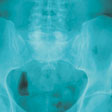 
Breathing
easier
(continued)
“We
want to be able to measure very small amounts of chemotherapeutic
agents to increase effectiveness and minimize side effects,”
said Gandara, also a professor of hematology/oncology at UC Davis
School of Medicine and Medical Center.
“All of us are different in our genetic makeup, in how our
bodies respond to drugs,” Turteltaub explained. “Yet
right now, chemotherapy regimens are based on an average individual.
We’d like to be able to go into each one of us to determine
what is exactly the right amount of a drug for us.”
Animal experiments must come first, to prove that the AMS can safely
trace and measure chemotherapy agents in living organisms.
The AMS also must be made smaller and cheaper if it is to join the
microscope or the x-ray as an indispensable medical tool.
Already, Livermore scientists have designed and built a more compact
version at a cost of about $1 million. (Livermore’s original
machine cost $7 million). Turteltaub and Dingley now use the smaller
machine for most of their human testing. While the compact AMS is
still big, it could be housed in a typical hospital.
Turteltaub is optimistic the new machine will indeed find a place
in medicine, beginning with cancer care. By using AMS data to tailor
chemotherapy to each patient and each cancer, he believes more cancer
patients will survive their disease.
“If we can do this, it will be a major accomplishment,”
Turteltaub said. “The last 10 to 15 years we have spent developing
this will have been worthwhile.
“All of us will feel very good about it.”
  

Home |
Table of Contents |
To our Readers |
Building on Basics
Focusing on Patients |
In Translation |
First Steps
Campus Connection |
Benefactors |
News in Brief
UC Davis Health System |
© 2000, 2001, 2002 UC Regents. All rights reserved.
|
 |



 
 
Radiation
exposure from a typical AMS study is less than a passenger absorbs
from the atmosphere during a flight from Sacramento to Los Angeles,
and far less than the radiation from a routine chest x-ray.
|



